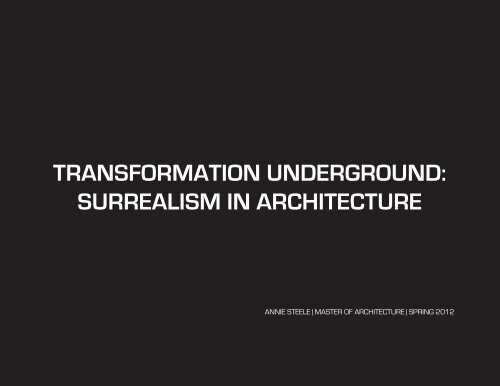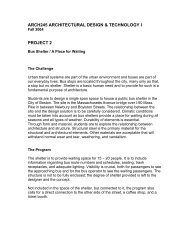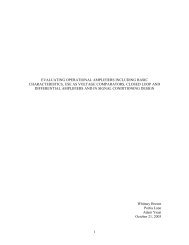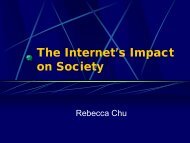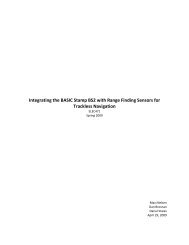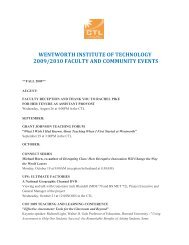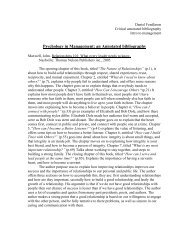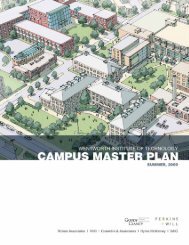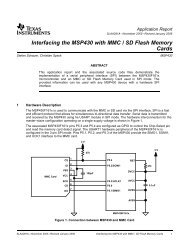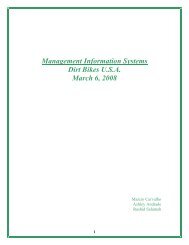Thesis Book - MyWeb at WIT
Thesis Book - MyWeb at WIT
Thesis Book - MyWeb at WIT
You also want an ePaper? Increase the reach of your titles
YUMPU automatically turns print PDFs into web optimized ePapers that Google loves.
TRANSFORMATION UNDERGROUND:<br />
SURREALISM IN ARCHITECTURE<br />
ANNIE STEELE | MASTER OF ARCHITECTURE | SPRING 2012
Many thanks to the following:<br />
dan hisel<br />
sue pereira<br />
fellow studio survivors<br />
friends & family
“The man who cannot visualize a horse galloping on<br />
a tom<strong>at</strong>o is an idiot.”<br />
“The imaginary is wh<strong>at</strong> tends to<br />
become real”<br />
- Andre Breton (f<strong>at</strong>her of surrealism)
1 INVESTIGATION OF THESIS TOPIC<br />
thesis abstract................11<br />
visual abstract................13<br />
objectives................15<br />
definitions................15<br />
idea map................17<br />
research essay........19-35<br />
annot<strong>at</strong>ed bibliography........37-41<br />
blog+ visual studies........43-47<br />
conclusion + hypothesis...............49<br />
2 FRAMING THE THESIS PROJECT<br />
site................53<br />
site d<strong>at</strong>a........55-57<br />
site analysis........59-63<br />
program...............65<br />
program functions...............65<br />
program diagrams...............67<br />
program + site fit analysis...............69<br />
3 THESIS SEMESTER: PROCESS<br />
methodology....................73<br />
surrealist techniques............75-85<br />
three dimensional collage....................87<br />
three dimensional assemblage....................89<br />
formal studies.............91-99<br />
experiential moments......101-107<br />
programm<strong>at</strong>ic narr<strong>at</strong>ive......111-131<br />
conceptual section.................133<br />
4 THESIS SEMESTER: RESULT<br />
floor plans...........................137-143<br />
sections......145-147,151,155<br />
perspectives.................149,153,157<br />
conclusion...........................159-161<br />
reflection......................................163<br />
TABLE OF CONTENTS
INVESTIGATION OF THE THESIS TOPIC
THESIS ABSTRACT<br />
This thesis is exploring the philosophy of surrealism and how to transl<strong>at</strong>e these fundamental ideas into an inhabitable surrealist<br />
space; a place where the imagin<strong>at</strong>ion is liber<strong>at</strong>ed, where the mind can reach a new awareness of consciousness, and where reality<br />
and fantasy are perceived as one ‘surreality’. This thesis is challenging the idea th<strong>at</strong> architecture might be perhaps the most useful<br />
medium of all to achieve the surrealist’s goals; th<strong>at</strong> is, to forget associ<strong>at</strong>ions, structures, and customs you already know in order<br />
to experience a new world th<strong>at</strong> your imagin<strong>at</strong>ion cre<strong>at</strong>es and inhabits. In this way, surrealists have been known for their irr<strong>at</strong>ional<br />
juxtapositions, and compositions based on autom<strong>at</strong>ism, which is allowing your impulses to take over conscious decisions.<br />
Surrealism is a philosophy cre<strong>at</strong>ed by Andre Breton in the 1920s, which embraces many realms of the cre<strong>at</strong>ive world, including<br />
painting, liter<strong>at</strong>ure, film, music and photography. Surrealists, such as artist Salvador Dali and director Luis Bunuel, used these<br />
mediums to convey this idea th<strong>at</strong> the world could be perceived in a new way. Surrealism has rarely appeared in built form, but<br />
surrealism as an inspir<strong>at</strong>ion has affected many architects, including Frederick Kiesler, Luis Barragan, and, briefly, Le Corbusier.<br />
Frederick Kiesler came the closest to cre<strong>at</strong>ing surrealist spaces, but most were never realized. This leads to the question: Is it<br />
possible to design an inhabitable space so th<strong>at</strong> the user experiences this notion of “surreality”, to intertwine the exterior reality of the<br />
physical world with the interior reality of fantasy?<br />
11
VISUAL ABSTRACT<br />
13
ACCOMPLISHMENTS:<br />
To gain experience in academic research, and to filter through relevant sources<br />
To <strong>at</strong>tain knowledge about the origins and theory of the surrealist movement<br />
To express ideas in scholarly written text, as well as engaging visual collage<br />
FUTURE OBJECTIVES:<br />
To explore different mediums in order to convey sp<strong>at</strong>ial ideas<br />
To transl<strong>at</strong>e theory based research into an architectural experience<br />
To clearly represent my ideas verbally and graphically<br />
OBJECTIVES<br />
DEFINITIONS<br />
Surrealism – A revolutionary movement led by philosopher Andre Breton, in the 1920s, as a reaction to the post-war life. Surrealism<br />
took its form in many mediums, including painting, poetry, photography, and film. The main objective of surrealism is to introduce a<br />
new reality through the convergence of the real life and the dream world.<br />
Surreality – the convergence of our interior reality (as in, our dreams, desire and unconscious) with the exterior reality (physical<br />
existence) to cre<strong>at</strong>e one absolute reality.<br />
Uncanny – unsettling, beyond wh<strong>at</strong> is expected, mysterious, unhomely, uncomfortable apprehension, beyond wh<strong>at</strong> is known<br />
Autom<strong>at</strong>ism – one of the many techniques surrealists used to cre<strong>at</strong>e their work; involved little to no self-conscious critique, similar<br />
to improvis<strong>at</strong>ion<br />
15
IDEA MAP<br />
17
RESEARCH ESSAY<br />
This thesis idea is to transl<strong>at</strong>e the fundamentals of surrealism into a way of thinking about sp<strong>at</strong>ial experiences and architectural<br />
design. The main philosophy of surrealism is to cre<strong>at</strong>e a new reality, which the Surrealists were seeking in the 1920s after World<br />
War 1, in order to transform the way we experience the world. The sources collected here all discuss the major theoretical ideas<br />
of surrealism in rel<strong>at</strong>ion to either architecture or film. Since this thesis is trying to cre<strong>at</strong>e surrealist architectural spaces, the most<br />
relevant sources are ones which discuss past <strong>at</strong>tempts and trials <strong>at</strong> exploring surrealist ideas in architecture, such as the 1978<br />
Feb./March Volume of Architecture Design, Anthony Vidler’s essay on Fantasy, the Uncanny and Surrealist Theories of Architecture,<br />
as well as Vidler’s introduction to The Architectural Uncanny. Vidler’s essays discuss the idea of the uncanny, which Vidler says can<br />
be found in the “st<strong>at</strong>e between dreaming and awakening”, and could be described as “a represent<strong>at</strong>ion of a mental st<strong>at</strong>e of projection<br />
th<strong>at</strong> precisely elides the boundaries of the real and the unreal in order to provoke a disturbing ambiguity, a slippage between waking<br />
and dreaming.” 1 On the other hand, the Architectural Design magazine articles focus on the beginnings and philosophy of surrealism,<br />
including quotes from Andre Breton, the founder of Surrealism, and examples of surrealist exhibitions and spaces. In addition, a<br />
more contemporary collection of essays in Surrealism and Architecture, edited by Thomas Mical, discuss how surrealist thought has<br />
made its way into architectural theory and method.<br />
The lack of built surrealist architecture can be <strong>at</strong>tributed to its extremely theoretical n<strong>at</strong>ure. Because of this, my sources<br />
rel<strong>at</strong>ing to surrealist cinema will be just as relevant in analyzing how the directors of those films transl<strong>at</strong>ed the idea of the real<br />
world versus the dream world into one reality. The two major influences in surrealist cinema th<strong>at</strong> appear in my sources are film<br />
director Luis Bunuel and surrealist painter Salvador Dali. Luis Bunuel directed the first surrealist films in the 1930s, which are Un<br />
Chien Andalou, and L’Age D’Or. Salvador Dali worked alongside Bunuel to instill surrealist ideas into the films. David Lynch, a more<br />
contemporary director of the films Eraserhead and Blue Velvet, becomes a focus of study as well due to his films depicting reality<br />
1 Anthony Vidler. The Architectural Uncanny: Essays in the Modern Unhomely. Cambridge, MA: MIT, 1992, 11<br />
19
and imaginary as one existence. The sources regarding Bunuel and Dali, since they were a collabor<strong>at</strong>ion, are Dali, Surrealism, and<br />
Cinema by Elliott King, Robert Short’s The Age of Gold: Dali, Bunuel, Artaud: Surrealist Cinema as well as Surrealism and Cinema<br />
by Michael Richardson. Chris Rodley collabor<strong>at</strong>ed with David Lynch to cre<strong>at</strong>e Lynch on Lynch, which is all about the director and his<br />
filmmaking. Along with reading books about these directors, the actual films themselves are being considered and viewed. Most of<br />
these authors discuss the idea of transforming the way we view the world by combining the physical reality with the mental dreamlike<br />
reality to make one reality, which is one of the main objectives of the Surrealist movement.<br />
Definition of Surrealism<br />
The intentions of the surrealist movement are <strong>at</strong> the forefront of many sources, which starts off the authors’ dialogue in a clear<br />
way. Dalibor Veseley contributed an important article in the 1978 volume of Architectural Design, in which he explains the vision of<br />
surrealism as a way of thinking and viewing the world, using quotes from primary sources written by Andre Breton. Veseley points<br />
out th<strong>at</strong> Breton believed “in the future resolution of those two seemingly contradictory st<strong>at</strong>es, dream and reality, of surreality, so to<br />
speak.” 2 Using this idea, Veseley deduces th<strong>at</strong> surrealists believed in a “new myth”, which is the surreality th<strong>at</strong> involved the “whole<br />
of human existence.” 3 This surreality is the “imaginary-real world of certain primitives, stripped of all supern<strong>at</strong>ural implic<strong>at</strong>ion and<br />
meanings.” 4 Stuart Knight’s “Observ<strong>at</strong>ions on Dada and Surrealism”, also in Architectural Design, adds th<strong>at</strong> surrealism is a “st<strong>at</strong>e<br />
of mind, a form of knowledge”, as opposed to just an art movement, th<strong>at</strong> was able to revolutionize the “dream world into a palpable<br />
reality.” 5 Author of Surrealism and Cinema, Michael Richardson notes th<strong>at</strong> surrealism is a convergence of the “different realms of<br />
existence” and “a meeting point between the opposites of light and dark, presence and absence, [and] actuality and imagin<strong>at</strong>ion.” 6<br />
Richardson claims surrealism is also a collabor<strong>at</strong>ive effort th<strong>at</strong> is still a “living thing.” 7 Similarly, Elliot H. King, author of Dali, Surrealism<br />
2 Surrealism and Architecture. Architectural Design 48, no. 2-3(1978), 87.<br />
3 Ibid, 88.<br />
4 Ibid.<br />
5 Ibid, 102.<br />
6 Michael Richardson. Surrealism and Cinema. Oxford; New York: Berg, 2006, 1.<br />
7 Michael Richardson. Surrealism and Cinema. Oxford; New York: Berg, 2006, 5.<br />
21
and Cinema, st<strong>at</strong>es th<strong>at</strong> surrealism aims to activ<strong>at</strong>e the subconscious mind, and th<strong>at</strong> cinema is the perfect medium for this. 8 Lastly,<br />
J. H. M<strong>at</strong>thews rest<strong>at</strong>es Breton’s ideas of surrealism in his Introduction to Surrealism as “enabling the mind to leap the barrier set<br />
up for it by the antinomies of reason and dreaming, reason and madness, feeling and represent<strong>at</strong>ion.” 9 The sources seemingly all<br />
agree on the definition of surrealism; th<strong>at</strong> surrealism is when the mind can converge both fantasy and reality into one existence. This<br />
thesis understands and agrees with th<strong>at</strong> definition, and will work towards designing an architecture th<strong>at</strong> embodies th<strong>at</strong> very idea.<br />
Surrealism in Architecture<br />
These authors all generally concur about the definition of surrealism; however, not all sources agree on the definition and<br />
presence of surrealism in Architecture. Veseley st<strong>at</strong>es th<strong>at</strong> architecture was not of interest to the surrealists, due to the surrealists’<br />
aspir<strong>at</strong>ions mainly focusing in art, sculpture, and objects. 10 Knight writes about the obvious contempt Breton had for Le Corbusier’s<br />
r<strong>at</strong>ional “modern style”, as Breton says modernism is “the most unhappy dream of the collective unconscious.” 11 Knight analyzes<br />
the superficial n<strong>at</strong>ure of Le Corbusier’s <strong>at</strong>tempts <strong>at</strong> using surrealist devices, such as the dreamlike quality Villa Savoye has sitting<br />
in the landscape, or the drifting quality of the ramps throughout the house. 12 Knight also mentions Le Corbusier’s “four walls, the<br />
lawn and the sky” with a “useless fireplace” <strong>at</strong> the Beistegui Apartment in Paris as a rudimentary <strong>at</strong>tempt <strong>at</strong> surrealism. 13 However,<br />
Vidler argues th<strong>at</strong> surrealism was, in fact, “the most modernist of the modernisms” due to the fact th<strong>at</strong> surrealists tried to unveil<br />
the repressed aspects of modernism; surrealism was a neg<strong>at</strong>ion of modernism. 14 Vidler also argues, against King, th<strong>at</strong> architecture<br />
is actually the best medium in which to portray surrealism. This is due to the physical aspects of architecture th<strong>at</strong> feel like a home,<br />
the symbolism th<strong>at</strong> occurs in the home, such as stairs or a cellar, and the sp<strong>at</strong>ial freedom with which the user can move – cre<strong>at</strong>ing<br />
8 Elliott H. King. Dali, Surrealism and Cinema. Harpenden, UK: Kamera <strong>Book</strong>s, 2007, 15.<br />
9 J. H. M<strong>at</strong>thews. An Introduction to Surrealism. University Park: Pennsylvania St<strong>at</strong>e University Press, 1965, 49.<br />
10 Surrealism and Architecture. Architectural Design 48, no. 2-3(1978), 91.<br />
11 Ibid, 101.<br />
12 Ibid, 109.<br />
13 Surrealism and Architecture. Architectural Design 48, no. 2-3(1978), 109.<br />
14 Anthony Vidler. Fantasy, the Uncanny and Surrealist Theories of Architecture. Papers of Surrealism Winter, no. 1: 2 (2003), 5.<br />
23
a site for the “uncanny” to manifest. 15 Vidler st<strong>at</strong>es th<strong>at</strong> the uncanny “is not a property of space itself nor can it be provoked by<br />
any particular sp<strong>at</strong>ial conform<strong>at</strong>ion”, but th<strong>at</strong> it is an “aesthetic dimension” th<strong>at</strong> erases the boundaries between “the real and the<br />
unreal.” 16 Finally, all the sources can agree on the aspir<strong>at</strong>ions of the only architect to <strong>at</strong>tempt surrealist architecture: Frederick<br />
Kiesler.<br />
According to Bernard Tschumi, author of the article “Architecture and Its Double”, which appeared in the 1978 volume of<br />
Architectural Design, Kiesler’s first surrealist space was the “space-stage” in 1923 for the production of RUR in Berlin. 17 Kiesler<br />
designed a funnel shaped auditorium space where the walls and ceilings could open up during the show. Tschumi describes Kiesler’s<br />
second surrealist project, ‘The Endless The<strong>at</strong>er’ in Vienna, which had an unfolding double shell of cast-glass, as well as ramps,<br />
elev<strong>at</strong>ors, and pl<strong>at</strong>forms to cre<strong>at</strong>e a continuous space th<strong>at</strong> did not separ<strong>at</strong>e functions. 18 Tschumi comments th<strong>at</strong> Kiesler turned<br />
to unbuilt architectural research, dealing with how spaces were inherently connected to a person’s deep unconscious. 19 Tschumi<br />
argues th<strong>at</strong> Kiesler’s <strong>at</strong>tempt <strong>at</strong> surrealist architecture have been ignored by architectural historians in favor of the 1920s movement<br />
towards Modernism. 20 Dalibor Veseley acknowledges th<strong>at</strong> Kiesler worked on his ‘Endless House’ for 40 years, arguably the most well<br />
known surrealist architectural design, cre<strong>at</strong>ing “a continuous space very much like a cave in the shape of an egg, with gre<strong>at</strong> freedom<br />
of movement inside, gre<strong>at</strong> flexibility for dividing the space.” 21 However, Veseley points out the fact th<strong>at</strong> the Endless House was never<br />
actually built, challenging the limits of “genuine surrealist architecture.” 22 Anthony Vidler questions whether Kiesler’s egg-shaped<br />
design is surrealist; as Kiesler himself has said th<strong>at</strong> it is more “Correalist”, meaning it had a “continual interaction between man<br />
and his n<strong>at</strong>ural and technological environments.” 23 Stephen Philips, author of “Introjection and Projection: Frederick Kiesler and his<br />
15 Anthony Vidler. Fantasy, the Uncanny and Surrealist Theories of Architecture. Papers of Surrealism Winter, no. 1: 2 (2003), 3.<br />
16 Ibid.<br />
17 Surrealism and Architecture. Architectural Design 48, no. 2-3(1978),116.<br />
18 Surrealism and Architecture. Architectural Design 48, no. 2-3(1978), 116.<br />
19 Ibid, 116.<br />
20 Ibid.<br />
21 Surrealism and Architecture. Architectural Design 48, no. 2-3(1978), 93.<br />
22 Ibid, 94.<br />
23 Anthony Vidler. Fantasty, the Uncanny and Surrealist Theories of Architecture. Papers of Surrealism Winter, no. 1:2 (2003), 2.<br />
25
dream machine”, which appears in Thomas Mical’s Surrealism and Architecture, agrees with Vidler, st<strong>at</strong>ing th<strong>at</strong> Kiesler’s aim was to<br />
cre<strong>at</strong>e an organic architecture th<strong>at</strong> “stimul<strong>at</strong>e[s] an idealized paradisiacal life inside an ergonomically designed illusionary cinem<strong>at</strong>ic<br />
sp<strong>at</strong>ial experience th<strong>at</strong> can expand and contract to engage one’s every motion and desire.” 24 Thus, Philips concludes th<strong>at</strong> Kiesler’s<br />
Endless House “finds its home between illusion and reality, continuity and individuality, vision and fact.” 25 It seems th<strong>at</strong> Kiesler is the<br />
pioneer of surrealist architecture, but th<strong>at</strong> his investig<strong>at</strong>ion, which started out as built work, turned into paper architecture. This<br />
thesis will <strong>at</strong>tempt to cre<strong>at</strong>e more than just theoretical architectural ideas, but actual sp<strong>at</strong>ial experiences th<strong>at</strong> convey this idea of<br />
a new way to perceive reality.<br />
Artaud: Surrealist Spaces<br />
In addition to Frederick Kiesler, Antonin Artaud is referenced in a few sources as also having thought about space in a surrealist<br />
way. Tschumi explains th<strong>at</strong> when Artaud joined the surrealists in 1924, he “<strong>at</strong>tacked the purely verbal and insisted on experience<br />
and sens<strong>at</strong>ion.” 26 Artaud believed th<strong>at</strong> to limit consciousness to wh<strong>at</strong> could be expressed in words was a mistake, and for this, he<br />
resented language and the autom<strong>at</strong>ism technique used in writing. 27 This worried Breton--probably because most of the surrealists<br />
were poets and writers--and Artaud was pushed out of the surrealist group. 28 Artaud’s concern was in sp<strong>at</strong>ial expression; he wanted<br />
to cre<strong>at</strong>e “a physical and mental havoc” so th<strong>at</strong> the audience would experience the unconscious. 29 Tschumi explains th<strong>at</strong> Artaud<br />
cre<strong>at</strong>ed a violent and psychological experience of the the<strong>at</strong>er; first, by having the show in an unexpected loc<strong>at</strong>ion, like a barn; second,<br />
by loc<strong>at</strong>ing the audience <strong>at</strong> the center of the show; and third, through gruesome images and uncomfortable lighting techniques. 30<br />
Similarly, Robert Short, author of The Age of Gold: Dali, Bunuel, Artaud: Surrealist Cinema, agrees th<strong>at</strong> space is an important element<br />
24 Thomas Mical. Surrealism and Architecture. London; New York: Routledge, 2005, 152.<br />
25 Ibid.<br />
26 Surrealism and Architecture. Architectural Design 48, no. 2-3(1978), 113.<br />
27 Surrealism and Architecture. Architectural Design 48, no. 2-3(1978), 114.<br />
28 Ibid.<br />
29 Ibid.<br />
30 Surrealism and Architecture. Architectural Design 48, no. 2-3(1978), 114.<br />
27
in Artaud’s film. Artaud is intrigued by the “expanding and manipul<strong>at</strong>ion [of the] sp<strong>at</strong>ial dimension”, as well as the “jarring interaction<br />
of elements of control and chance.” 31 Short argues th<strong>at</strong> this is where the surrealist motiv<strong>at</strong>ions are expressed; when the “opposites<br />
meet and collide – divisions between reality and fiction, and between the individual and an engulfing society.” 32 Artaud is able to use<br />
the<strong>at</strong>er as a c<strong>at</strong>alyst for surrealist experiences, in th<strong>at</strong> there is an audience as well as performers. This dialogue cannot literally<br />
appear in architecture; but perhaps the architecture can act as the performer and the visitor can be the audience.<br />
Surrealist Film<br />
Artaud’s explor<strong>at</strong>ion into the medium of cinema as a surrealist led the way for directors Luis Bunuel and Salvador Dali to<br />
collabor<strong>at</strong>e and cre<strong>at</strong>e the most famous surrealist films, Un Chien Andalou and L’Age d’Or. Michael Richardson questions Bunuel’s<br />
authorship to L’age d’Or because it was actually a collabor<strong>at</strong>ive script written by the surrealist group, including Max Ernst, Gaston<br />
Modot, Jacques Prevert, and Jean Aurenche. 33 Richardson even goes so far as to comment on Bunuel’s true intentions with<br />
surrealism, referring back to his resign<strong>at</strong>ion from the surrealist group in 1932 in order to join the communists. 34 Richardson does<br />
acknowledge Dali’s influence in Bunuel’s films, but does not delve into th<strong>at</strong> topic. An interesting point made by Richardson was th<strong>at</strong><br />
Bunuel does not ever talk about wh<strong>at</strong> he thinks about L’Age d’Or35 , similarly to how Chris Rodley, author of Lynch on Lynch, reveals<br />
th<strong>at</strong> David Lynch despises and refuses to discuss an analysis of wh<strong>at</strong> his movies are about. 36 Robert Short, on the other hand,<br />
focuses on how the films came about, and the rel<strong>at</strong>ionship between Dali and Bunuel. Short describes how Un Chien Andalou was<br />
surrealist even in its cre<strong>at</strong>ion due to the chance encounter th<strong>at</strong> Dali and Bunuel were both available and ready to cre<strong>at</strong>e a surrealist<br />
film, and the process of writing the script together. 37 Short goes through the film scene by scene, pointing out potential symbolic<br />
31 Robert Short. The Age of Gold: Dali, Bunuel, Artaud: Surrealist Cinema. New expanded ed. Los Angeles, Calif: Solar, 2008, 43-47<br />
32 Ibid, 48.<br />
33 Michael Richardson. Surrealism and Cinema. Oxford; New York: Berg, 2006, 29.<br />
34 Ibid, 33.<br />
35 Michael Richardson. Surrealism and Cinema. Oxford; New York: Berg, 2006, 33.<br />
36 David Lynch, Chris Rodley. Lynch On Lynch. Rev. Ed. Ed. London: Faber, 2005, xi.<br />
37 Robert Short. The Age of Gold: Dali, Bunuel, Artaud: Surrealist Cinema. New expanded ed. Los Angeles, Calif: Solar, 2008, 64.<br />
29
eferences or meanings. According to Short, Dali did not particip<strong>at</strong>e in the shooting of L’Age d’Or, but agrees with Richardson, in<br />
th<strong>at</strong> it was a collective effort to cre<strong>at</strong>e the script by the surrealist group. 38 Short expands upon this in describing the film as more<br />
functional, with the style of a documentary, having limited camera movement and almost no autom<strong>at</strong>ism. 39 These films mark the<br />
end of Dali and Bunuel’s partnership in filmmaking; Short describes the falling out between the two as a disagreement over who got<br />
credit for certain parts of the films.<br />
As for more contemporary surrealist cinema, director David Lynch seems to be up for deb<strong>at</strong>e as whether he should be considered<br />
surrealist. In Vidler’s introduction in The Architectural Uncanny, Vidler briefly mentions Lynch’s Blue Velvet and Twin Peaks as a place<br />
where “domestic and suburban uncanny” appear. 40 Vidler defines the uncanny as “a slippage between waking and dreaming”, so the<br />
author seemingly agrees th<strong>at</strong> Lynch works with surrealist ideas. 41 Robert Short st<strong>at</strong>es th<strong>at</strong> David Lynch accepted th<strong>at</strong> his collection<br />
of avant-garde films fe<strong>at</strong>ured in a BBC documentary in the 1980s were labeled as “surrealist.” 42 In addition, in Chris Rodley’s Lynch on<br />
Lynch, David Lynch explains how when he was in need of inspir<strong>at</strong>ion during the filming of Mullholland Drive, he reverted to “surrealist<br />
tricks”, where they got a bunch of words and jumbled them up to get ideas based on random associ<strong>at</strong>ions. Lynch describes it as “your<br />
mind focuses on a certain thing and it pulls in ideas th<strong>at</strong> will marry to th<strong>at</strong> thing in a surprising way, because this is a surprising set<br />
of circumstances.” 43 So not only are Lynch’s films uncanny, but he utilizes surrealist techniques for his filmmaking. Rodley expands<br />
upon Vidler’s notion of the uncanny by claiming th<strong>at</strong> Lynch is interested in the defamiliariz<strong>at</strong>ion process, as well as the st<strong>at</strong>e between<br />
dream and awakening. 44 Rodley st<strong>at</strong>es, “Insecurity, estrangement and lack of orient<strong>at</strong>ion and balance are sometimes so acute in<br />
Lynchland th<strong>at</strong> the question becomes one of whether it is possible to ever feel ‘<strong>at</strong> home.’” 45 Where there is disagreement, however, is<br />
38 Robert Short. The Age of Gold: Dali, Bunuel, Artaud: Surrealist Cinema. New expanded ed. Los Angeles, Calif: Solar, 2008,106.<br />
39 Ibid, 108.<br />
40 Anthony Vidler. The Architectural Uncanny: Essays in the Modern Unhomely. Cambridge, MA: MIT, 1992, 10.<br />
41 Ibid.<br />
42 Robert Short. The Age of Gold: Dali, Bunuel, Artaud: Surrealist Cinema. New expanded ed. Los Angeles, Calif: Solar, 2008, 20.<br />
43 David Lynch, Chris Rodley. Lynch On Lynch. Rev. Ed. Ed. London: Faber, 2005, 284.<br />
44 Ibid, xi.<br />
45 Ibid.<br />
31
in Michael Richardson’s Surrealism and Cinema, where he argues while Lynch does use a surrealist visual style, he lacks the essence<br />
of surrealism, which is to make a direct connection with the viewer and instill the will to “change life and transform the world.” 46 Lynch<br />
instead, as Richardson claims, does not fully understand surrealism and seems to merely play mind games with the viewer. 47 Since<br />
the films discussed here are known to be surrealist, this thesis will study wh<strong>at</strong> techniques the directors used to achieve th<strong>at</strong> level of<br />
‘surreality’; techniques including the composition of light and shadow, the juxtaposition of objects, the volume of the accompanying<br />
soundtrack, and the configur<strong>at</strong>ion of space and time.<br />
Conclusion<br />
These sources, although sometimes contradicting, are very inform<strong>at</strong>ive on this thesis topic of trying to cre<strong>at</strong>e a surrealist space.<br />
Through discussing the very definition of surrealism itself, to the deb<strong>at</strong>e about surrealism in architecture, specifically referring to<br />
architect Frederick Kiesler, the goal of surrealism—th<strong>at</strong> is, cre<strong>at</strong>ing a new reality--is evident. Then, exploring the spaces cre<strong>at</strong>ed<br />
by Antonin Artaud led into the discussion of surrealism and cinema, where the surrealist n<strong>at</strong>ure of Luis Bunuel and Salvador Dali’s<br />
famous films was discussed. Finally, the deb<strong>at</strong>e whether David Lynch should even be included in the surrealist film c<strong>at</strong>egory was<br />
opened up. The similarly between all these themes is th<strong>at</strong> the underlying intention of surrealism is there; to get to the point where<br />
contradictions of fantasy and reality meet to cre<strong>at</strong>e a new “surreality”, as Breton put it. 48 This thesis topic is only part of a much<br />
larger deb<strong>at</strong>e about surrealism in architecture, which appears to be surfacing more and more, as seen with the recent public<strong>at</strong>ion<br />
of Surrealism and Architecture by Thomas Mical in 2005. The current convers<strong>at</strong>ions regarding surrealism are rel<strong>at</strong>ed more with<br />
method, as seen in Neil Spiller’s essay “Communic<strong>at</strong>ing Vessels” (2011). Spiller predicts, “as technology progresses, architects will<br />
have to re-evalu<strong>at</strong>e Surrealist notions of space, time, m<strong>at</strong>eriality, and memory.” 49 Even though surrealism began in the 1920s, and<br />
46 Michael Richardson. Surrealism and Cinema. Oxford; New York: Berg, 2006, 74,<br />
47 Ibid.<br />
48 Surrealism and Architecture. Architectural Design 48, no. 2-3(1978), 87.<br />
49 Mark Garcia. The Diagrams of Architecture. United Kingdom, 2011, 178. I have just recently been introduced to this source; so my understanding of Neil Spiller’s ideas is very<br />
incomplete. I will be looking more into his contemporary surrealist ideas.<br />
33
hardly any surrealist architecture has been built, it seems th<strong>at</strong> surrealism is still relevant today, in design methods and theory. It is<br />
important for surrealism to continue to appear so th<strong>at</strong> more people view and experience their world in another way. This thesis’s<br />
surrealist approach to designing architectural spaces <strong>at</strong>tempts to choreographic the user’s perception through circul<strong>at</strong>ion, as well<br />
as challenge the notion of wh<strong>at</strong>’s real and unreal through m<strong>at</strong>eriality, screens, projections, and shadows.<br />
35
Surrealism and Architecture. Architectural Design 48, no. 2-3(1978): 87-to 169<br />
ANNOTATED BIBLIOGRAPHY<br />
This February/March 1978 volume of Architectural Design focuses on a compil<strong>at</strong>ion of writings about surrealism and architecture.<br />
This is very relevant to my thesis topic because many of the writers discuss surrealism and it’s theoretical place in the architectural<br />
realm. In one of the articles, Dalibor Veseley discusses in detail the philosophy of surrealism as defined by Andre Breton with direct<br />
quotes, such as how surrealism aims to “reach an absolute point of reconcili<strong>at</strong>ion of dream and reality”. Veseley also explains the<br />
techniques used by surrealists, such as “pure psychic autom<strong>at</strong>ism”, the idea of the “poetic analogy” th<strong>at</strong> could be used in architecture,<br />
and Frederick Kiesler’s example of surrealism in architecture in the Endless House. This collection of writings would be useful for<br />
anyone doing academic research on surrealism, architecture or theory.<br />
King, Elliott H. Dali, Surrealism and Cinema. Harpenden, UK: Kamera <strong>Book</strong>s, 2007.<br />
Dali, Surrealism, and Cinema (2007), written by Elliott H. King, focuses on Salvador Dali’s <strong>at</strong>tempts and failures <strong>at</strong> cre<strong>at</strong>ing surrealist<br />
films, as well as television. King devotes the book to discussing 20 of Dali’s films, whether complete or not. Elliott H. King is a<br />
contemporary art historian who is an Assistant Professor of Art History <strong>at</strong> Rhodes College in Memphis, Tennessee, and specializes<br />
in Salvador Dali’s art and writing. This source will be extremely relevant to my thesis, as it discusses one of the key people in the<br />
cre<strong>at</strong>ion of Surrealism, Dali, and how he rel<strong>at</strong>ed the ideas in his paintings into film. King includes an interview with Amanda Lear, one<br />
of Dali’s closest confidants.<br />
Lynch, David, Rodley, Chris. Lynch on Lynch. Rev. Ed ed. London: Faber, 2005<br />
Chris Rodley writes Lynch on Lynch in 2005, which is about the film director David Lynch and his films. Rodley has many hours of<br />
interview time with David Lynch, which is rare. This book explores Lynch’s thoughts on his own works, and includes anecdotal stories<br />
from his childhood background. Lynch discusses his process of filmmaking as feeling a “mood” as he films th<strong>at</strong> influences each scene,<br />
which sounds similar to the idea of autom<strong>at</strong>ism. Lynch does not address surrealism, but r<strong>at</strong>her it is evident he is expressing the<br />
theory and ideas of surrealism in the meaning of his works, as he tries to merge the dream world with the real world. This book is<br />
very relevant to my thesis topic because David Lynch directs many of the films I am studying. This book would be helpful for anyone<br />
interested in film, David Lynch, and surrealist or dreamlike movies.<br />
37
M<strong>at</strong>thews, J. H. An Introduction to Surrealism. University Park: Pennsylvania St<strong>at</strong>e University Press, 1965.<br />
J. H. M<strong>at</strong>thews writes An Introduction to Surrealism in 1965 to emphasize th<strong>at</strong> it is the <strong>at</strong>titude of the mind th<strong>at</strong> m<strong>at</strong>ters in any<br />
movement, and th<strong>at</strong> the Surrealists comments on art are more important than the comments of any art critic. This source is<br />
relevant to my thesis due to its comprehensive knowledge of the theory and ideas behind the Surrealist Movement. J. H. M<strong>at</strong>thews<br />
has written many books on Surrealism, and is currently teaching <strong>at</strong> the University of Minnesota.<br />
Mical, Thomas. Surrealism and Architecture. London ; New York: Routledge, 2005.<br />
Thomas Mical, author of the book Surrealism and Architecture (2005), claims th<strong>at</strong> surrealism is the least examined artistic movement<br />
informing modern architecture, and should be looked <strong>at</strong>, as it is inform<strong>at</strong>ive of the “desires” of architecture. The purpose of Mical’s<br />
work is to organize these essays about surrealism in order to cre<strong>at</strong>e a dialogue about how surrealism is indeed a part of architecture’s<br />
history, influencing many architects way of thinking, even though it has been a “dark secret” in architecture. Thomas Mical received<br />
his professional architecture degree from Harvard, and is known for his lectures and writings on surrealism, cinema, and urbanism.<br />
This source is directly rel<strong>at</strong>ed to my thesis in th<strong>at</strong> the book examines a correl<strong>at</strong>ion between surrealism and architecture.<br />
Richardson, Michael. Surrealism and Cinema. Oxford; New York: Berg, 2006.<br />
Michael Richardson, author of Surrealism and Cinema (2006) explores the conceptualiz<strong>at</strong>ion and making of surrealist films, focusing<br />
on a broader range of directors than solely Luis Bunuel, from the 1920s to present day, with a focus on surrealist director Jan<br />
Svankmajer. Richardson claims th<strong>at</strong> certain films are directly, indirectly and involuntarily involved with the ideas of surrealism,<br />
dreams, and the unconscious. Richardson also discusses criteria th<strong>at</strong> begin to articul<strong>at</strong>e “intangible rel<strong>at</strong>ion”, and this idea by<br />
Kyrou th<strong>at</strong> going to the cinema itself is a surrealist experience, cre<strong>at</strong>ing a collective rel<strong>at</strong>ionship of the viewer to the screen. Anyone<br />
interested in surrealism and film should read this book. Michael Richardson wrote other books about surrealism, and is currently a<br />
visiting professor <strong>at</strong> Waseda University in Tokyo.<br />
39
Short, Robert. The Age of Gold: Dali, Bunuel, Artaud: Surrealist Cinema. New expanded ed. Los Angeles, Calif.: Solar, 2008.<br />
Robert Short explores the films Un Chien Andalou and L’Age D’or in his book The Age of Gold, written in 2008. This book documents<br />
the themes and images of the films, as well as the theories of Dadaist and Avant-garde films for comparison. This source is very<br />
relevant for my topic due to the depth of research into the two most important surrealist movies. Robert Short is a lecturer <strong>at</strong> the<br />
University of East Anglia in England. This book is a useful academic reading for anyone interested in surrealist films and theory.<br />
Svacha, Rostislav. Surrealism and Architecture [ed. by] Thomas Mical. Umeeni = the Art 55, no. 6: 510-513, 2007<br />
Rostislav Svacha wrote a book review on Surrealism and Architecture by Thomas Mical, in 2007, claiming th<strong>at</strong> Mical’s collection of<br />
essays about surrealism and architecture, written by many young authors, is not a very thorough book on the subject. Syacha intends<br />
to inform readers of Thomas Mical’s “Surrealism and Architecture” specifically to this claim, as well as researchers interested in<br />
surrealism and architecture. This review was helpful for my thesis topic, in th<strong>at</strong> the article reminded me to question the author’s<br />
expertise and experience.<br />
Vidler, Anthony. Fantasy, the Uncanny and Surrealist Theories of Architecture. Papers of Surrealism Winter, no. 1: 2 (2003)<br />
Anthony Vidler wrote this paper, “Fantasy, the Uncanny and Surrealist Theories of Architecture” in 2003 in <strong>at</strong>tempts to compare the<br />
theory of surrealism with actual ideas of built architecture, as well as architectural theory. Vidler discusses the ideas of the physical<br />
and the mental, as well as the organic and the inorganic. These ideas are very important to my thesis topic. This article is helpful for<br />
anyone interested in surrealism and architecture. Anthony Vidler is a Professor and Dean of the School of Architecture <strong>at</strong> Cooper<br />
Union, as well as being a historian and theorist of modern and contemporary architecture.<br />
Vidler, Anthony. The Architectural Uncanny: Essays in the Modern Unhomely. Cambridge, MA: MIT, 1992.<br />
Anthony Vidler’s book “The Architectural Uncanny” focuses on the subject of the uncanny. The different aspects of the uncanny are<br />
split up into specific essays, such as exile and homelessness. This book, specifically the introduction, was relevant to this thesis due<br />
to it’s connection to surrealism with the uncanny. Anthony Vidler is a Professor and Dean of the School of Architecture <strong>at</strong> Cooper<br />
Union, as well as being a historian and theorist of modern and contemporary architecture.<br />
41
BLOG<br />
Prior to the start of the semester, I began a collection of images th<strong>at</strong> were inspir<strong>at</strong>ional and influential to my interests. These items<br />
included art install<strong>at</strong>ions, paintings, artwork by architects and graphic designers, videos and filmography, photography and quotes.<br />
This collection showed my p<strong>at</strong>terns of thinking and interests, which eventually led to my thesis idea: Surrealism in Architecture. In<br />
addition to organizing my thesis ideas, the blog was helpful in displaying my weekly work for <strong>Thesis</strong> Prep. Each week I built upon the<br />
previous weeks work. When scrolling through my blog, you can see the progression and evolution of ideas. This is an especially useful<br />
tool for an outsider to visit my blog and understand my journey throughout my pre-thesis semester.<br />
steelea.tumblr.com<br />
43
VISUAL STUDIES - PASSAGE OF TIME<br />
45
VISUAL STUDIES - MOVEMENT<br />
47
CONCLUSION<br />
Conducting scholarly research in the field of surrealism allows me to understand the goals of surrealism, the major contributors th<strong>at</strong><br />
define the movement, and the past <strong>at</strong>tempts <strong>at</strong> transl<strong>at</strong>ing surrealism into art. The visual studies help g<strong>at</strong>her precedents, organize<br />
my analysis and cre<strong>at</strong>ive interpret<strong>at</strong>ion, and establish the site and program of my thesis problem. This research, in collabor<strong>at</strong>ion with<br />
the visual studies, helps me to set up the framework of my thesis project.<br />
HYPOTHESIS<br />
This thesis aims to cre<strong>at</strong>e an architectural sp<strong>at</strong>ial experience where the exterior reality merges with the interior reality, in which the<br />
user perceives a new surreality. Throughout next semester, I hope this thesis will discover ideas about how to convey fantasy and<br />
desire versus reality and truth as one through utilizing illusions, transparencies, shadows, and adjacencies. In the end, this thesis will<br />
determine if surrealist spaces can be designed and experienced by a user to perceive the world in a new type of reality.<br />
49
FRAMING THE THESIS PROJECT
SITE<br />
ABANDONED UNDERGROUND SUBWAY TUNNEL<br />
ON TREMONT STREET IN BOSTON, MA.<br />
The criteria this thesis had for choosing a site is th<strong>at</strong> the site is a place with a past, an element of time. The site is also to be<br />
underground or partially dug into the site, with elements of light and dark. Additionally, the site should have distant noises in the<br />
background, like a train. Loc<strong>at</strong>ed in an urban place, this site could even take over an existing structure. The idea of a p<strong>at</strong>h and<br />
sequence in this space is important. With all these in mind, this thesis site is loc<strong>at</strong>ed in Boston’s first underground subway <strong>at</strong><br />
Tremont Street. It was built in 1897, and was active until 1961. Now the tunnel, which is ¼ mile long, is abandoned and unused. This<br />
site, being next to the Boston Commons, as well as in the The<strong>at</strong>er District, works well due to its loc<strong>at</strong>ion being in the urban center of<br />
Boston. This is where the site and the program overlap to work together.<br />
53
SITE DATA - MAPS<br />
55
SITE DATA - PHOTOGRAPHS<br />
57
While studying potential sites, I decided to<br />
make my own film. Pictured here are some of<br />
the stills from the finished product. In the film,<br />
I merged two sites: the underground subway<br />
tunnel, and an abandoned Steinert’s Music<br />
Hall in Boston. The film conveyed some of the<br />
ideas about site criteria; this idea of passage of<br />
time, the underground and abandoned existing<br />
structures, and the distant noise of the train.<br />
SITE ANALYSIS<br />
59
SITE ANALYSIS<br />
61
SITE ANALYSIS<br />
63
PROGRAM<br />
The programm<strong>at</strong>ic function for this thesis is very important in th<strong>at</strong> the program should not solve this thesis for me. For example,<br />
if the program was a circus, th<strong>at</strong> would be unexpected and surreal in itself. This thesis needs a program th<strong>at</strong> is concrete so th<strong>at</strong><br />
the experience itself can be surreal. The program would need the element of visitors arriving only a few times a year, so th<strong>at</strong> their<br />
experience is new. Additionally, the program would have opportunities for more circul<strong>at</strong>ion between spaces. The programm<strong>at</strong>ic<br />
needs would not require light or windows, due to the site being underground. In considering these criteria, the programm<strong>at</strong>ic function<br />
of this thesis is a Hostel. A hostel follows all of these criteria; the visitors would be new to this designed space, they would circul<strong>at</strong>e<br />
between their rooms to the common areas, and the hostel would actually work better without light since the main purpose<br />
would be sleeping. The visitors of the hostel would be open to new experiences and would be the perfect users of this space.<br />
HOSTEL [SERVES ABOUT 60 VISITORS]<br />
FUNCTION SIZE IN SF QTY. TOTAL SF<br />
Reception Area 20 x 12 = 240 SF 1 240 SF<br />
Management Office 12 x 16 = 192 SF 1 152 SF<br />
Kitchen 20 x 20 = 400 SF 2 800 SF<br />
Common Area 20 x 20 = 400 SF 2 800 SF<br />
Storage + Supplies 20 x 20 = 400 SF 1 400 SF<br />
1 Bedroom 18 x 10 = 180 SF 6 1,080 SF<br />
2 Bedroom 18 x 12 = 216 SF 6 1,296 SF<br />
3 Bedroom 18 x 15 = 270 SF 6 1,620 SF<br />
4 Bedroom 20 x 20 = 400 SF 6 2,400 SF<br />
Communal B<strong>at</strong>hrooms 20 x 20 = 400 SF 4 1,600 SF<br />
NET SQ. FT. = 10, 548<br />
GROSS SQ FT. = 13, 712<br />
SITE TO FIT SQ. FT = 15, 768<br />
65
PROGRAM DIAGRAMS<br />
67
PROGRAM + SITE FIT ANALYSIS<br />
69
THESIS SEMESTER: PROCESS
METHODOLOGY<br />
My process throughout the semester dealt with “letting go” of r<strong>at</strong>ional thought (which was very difficult!). The first few explor<strong>at</strong>ions<br />
were about intuitive thought, limiting moral and social concerns from the process, and a lack of editing but a surplus of meaning.<br />
From there, the process informed itself. One explor<strong>at</strong>ion led to another. Below is the mind map which documented each step along<br />
the way.<br />
73
TWO-DIMENSIONAL SURREALIST TECHNIQUES<br />
“Recipe”:<br />
1. Begin with known image or object<br />
2. Following the set of ‘rules’ so th<strong>at</strong> the author doesn’t make decisions on how they are changing the image or object.<br />
Minimal thinking; just doing (autom<strong>at</strong>ic)<br />
3. This abstracts it in a way th<strong>at</strong> has no order / randomized (takes away the “authorship” since there is little conscious<br />
input/no r<strong>at</strong>ional thinking)<br />
Each technique presents an opportunity for chance:<br />
Chance on which initial image or object is chosen<br />
Chance on the author’s impulses/intuition with how things go back together (when decisions present themselves, you think<br />
as little as possible to avoid r<strong>at</strong>ionalizing why you are doing wh<strong>at</strong> you are doing).<br />
Result:<br />
Look <strong>at</strong> image/object in a different way with discoveries and new possibilities of wh<strong>at</strong> it means and can be viewed as.<br />
Inspire thoughts/ideas/connections th<strong>at</strong> wouldn’t have been reached with r<strong>at</strong>ional thought.<br />
Criticism:<br />
The techniques require some level of consciousness; these techniques <strong>at</strong>tempt to reveal wh<strong>at</strong> the subconscious desires –<br />
but I don’t know if th<strong>at</strong>’s truly possible with these techniques.<br />
The important piece of this technique is after the process – the discoveries and possibilities th<strong>at</strong> arise out of the process.<br />
These techniques still allow for some sort of legibility – it was important for the surrealists th<strong>at</strong> their viewers of the artwork<br />
could comprehend some piece of reality infused with irr<strong>at</strong>ionality. After all, their main goal was to bring about social<br />
awareness of this philosophy and how would they do th<strong>at</strong> if the public couldn’t read into their work?<br />
(Abstract Expressionism was more about the artist expressing himself, so the painting could be totally incomprehensible).<br />
Wh<strong>at</strong> would happen if I combined two techniques? Is there a new technique th<strong>at</strong> would allow minimal r<strong>at</strong>ional thought to be involved<br />
during the process?<br />
75
AEROGRAPHY<br />
use of a 3D object as a stencil for spray painting<br />
77
CUBOMANIA<br />
picture/image is cut into squares then reassembled with no regard for the previous image<br />
79
CUT-UP TECHNIQUE<br />
text is cut up and rearranged to cre<strong>at</strong>e new text<br />
81
ENTOPIC GRAPHOMANIA<br />
cre<strong>at</strong>e dots and connect with line or curved lines<br />
83
OUTAGRAPHY<br />
the object of the image/photograph is cut out<br />
85
This explor<strong>at</strong>ion was taking the ideas of the two dimensional collages and trying to<br />
produce a more sp<strong>at</strong>ial collage. I started by going to the local goodwill, picking items<br />
<strong>at</strong> random, then putting them together without thought. Looking <strong>at</strong> it afterwards, I<br />
imagined th<strong>at</strong> the fishbowl was this man’s brain with all these memories of his life as<br />
objects. In this way, I was able to cre<strong>at</strong>e a narr<strong>at</strong>ive of someone’s life with cues from<br />
the fishbowl. Another interesting note is th<strong>at</strong> the way I placed the objects initially for<br />
the photograph was completely unthought about, but when looking <strong>at</strong> it afterwards,<br />
it shows my inner r<strong>at</strong>ional personality and how I intuitively c<strong>at</strong>egorized the items.<br />
THREE-DIMENSIONAL COLLAGE<br />
87
THREE-DIMENSIONAL ASSEMBLAGE<br />
Taking cues from Joseph Cornell, I decided to try my own assemblage, as a way to cre<strong>at</strong>e new meanings for objects when they are<br />
in juxtaposition with each other. This was another way for me to work without trying to have a reason for every decision.<br />
89
FORMAL STUDIES BASED ON SHADOWS<br />
I came up with the idea to then make an open-back assemblage, so th<strong>at</strong> I could shine a light through and abstract the objects into<br />
shapes using the shadows. Once again, I did not give aesthetic regard to how the assemblage looked, I just placed objects together.<br />
The shadows were then cast onto a wall, traced with charcoal, and given tonal qualities, to cre<strong>at</strong>e sp<strong>at</strong>ial rel<strong>at</strong>ionships. These<br />
charcoals, which are 3’ x 4’ large, were scaled down and modeled with corrug<strong>at</strong>ed cardboard into 4” thick forms. In a way, the<br />
process here was model to photograph to drawing and back to model... which then eventually led back to photograph!<br />
91
STUDY ONE<br />
93
STUDY TWO<br />
95
STUDY THREE<br />
97
STUDY FOUR<br />
99
EXPERIENTIAL MOMENTS<br />
Using the 4” models, I stacked them together and manipul<strong>at</strong>ed the lighting to take photographs in a way th<strong>at</strong> felt experiential. These<br />
moments helped cre<strong>at</strong>e a narr<strong>at</strong>ive of formal spaces.<br />
101
EXPERIENTIAL MOMENTS<br />
103
EXPERIENTIAL MOMENTS<br />
105
EXPERIENTIAL MOMENTS<br />
107
EXPERIENTIAL SECTION<br />
Using the experiential moments, I cre<strong>at</strong>ed a sectional narr<strong>at</strong>ive of spaces. These formal studies show spaces th<strong>at</strong> influenced my<br />
design.<br />
109
PROGRAMMATIC NARRATIVE<br />
Using an ab-lib technique, i filled in the blanks for “a ____ for ____ ____” with nouns, adjectives, and verbs. These phrases were<br />
now my programm<strong>at</strong>ic script for the rooms of my building.<br />
111
A FROZEN VAULT OF REPORTS<br />
first space visitor encounters | mostly normal<br />
receptionist disappears into a vault, where fog emits into the space | vault keeps records “preserved”, kept safe<br />
113
A WARM BALCONY FOR HOLDING BAGS<br />
balcony in the exposed tunnel | fireplace warming the luggage of the visitors<br />
still not extremely surreal, just a double take | personifying bags<br />
115
A GARDEN OF BROAD INSTRUMENTS<br />
garden: communic<strong>at</strong>ion to the exterior | broad: many, varied | instruments: tools of the traveler<br />
return back to the ‘garden’ multiple times | tools th<strong>at</strong> travelers use to connect to the outside world<br />
117
A BEDROOM OF MOLTEN MEMORY<br />
texture: pins th<strong>at</strong> can mold to the movement of the user | communic<strong>at</strong>ion back and forth between rooms<br />
saves memory of the user of the room | always changing<br />
119
A POOL OF EMPTY CURTAINS<br />
bedroom th<strong>at</strong> fits multiple people | priv<strong>at</strong>e beds are formed from the architecture but are all connected to the pool<br />
in this case the curtains are not “concealing”; they are fabric on which to rest<br />
121
A LANE OF FAMILIAR TOILETS<br />
idea of shadows; seeing the outline and familiarity of the b<strong>at</strong>hroom | curtains are used for concealing<br />
cre<strong>at</strong>e the image of a textured wall | “pool” indic<strong>at</strong>es w<strong>at</strong>er in the pool, but the w<strong>at</strong>er is outside the pool.<br />
123
THE FLOOR OF DROWSY WHIRLPOOLS<br />
lay on your bed, and the bed travels slowly in a downwards spiral | lulls you to sleep<br />
multiple people in one vast space<br />
125
THE MOUNTAIN OF QUIET FURNISHINGS<br />
old furniture stacked to cre<strong>at</strong>e terraces | climb terraces to different levels of beds | many steps to the top<br />
as you climb, instead of getting a view out, you look into the mountain and get a view of the auditorium practices<br />
127
AN AUDITORIUM OF DESERTED EYES<br />
the<strong>at</strong>er rehearsal space for emerson students (who occupy the building above)<br />
the hostel visitors can peak into this space while they climb up to their beds<br />
129
A KITCHEN OF MEMORIZING TAILS<br />
preserving the memory of the end | kitchen: transform<strong>at</strong>ion, memorizing: preserve, projection | tail; end<br />
camera records person in elev<strong>at</strong>or <strong>at</strong> the end of their journey, <strong>at</strong> the threshold moment before they leave the hostel | their<br />
image will be added to a queue of others, and is played in the dining area, so a memory of them will stay <strong>at</strong> the hostel<br />
131
CONCEPTUAL SECTION<br />
This diagramm<strong>at</strong>ic section was cre<strong>at</strong>ed based on the programm<strong>at</strong>ic script and the corresponding perspectives.<br />
133
THESIS SEMESTER: RESULT
GROUND PLAN<br />
The site is loc<strong>at</strong>ed on Tremont Street in Boston, MA. Entering the hostel through a Dunkin’ Donuts supply closet, you walk down a<br />
fire stair and into the reception area. The idea is to enter the hostel through a very mundane place, and progressively the visitor’s<br />
journey becomes surreal. Its the juxtaposition of the ordinary to the surreal th<strong>at</strong> makes the experience. The user can exit the<br />
hostel through the lobby of the Majestic The<strong>at</strong>er, which is extremely orn<strong>at</strong>e with decor<strong>at</strong>ion.<br />
137
FLOOR NEGATIVE ONE<br />
Once the user travels down the fire stair, they enter into the abandoned tunnel. Here there is a balcony with some programm<strong>at</strong>ic<br />
functions, such as check in, lobby and an office. The visitor has a chance to walk along the old train tracks, and then steps onto a<br />
pl<strong>at</strong>form where there are elev<strong>at</strong>or doorways and lounges. Each elev<strong>at</strong>or brings the user to a different part of the hostel, using a<br />
system of sloped wires th<strong>at</strong> the elev<strong>at</strong>or is suspended from. The visitor would have many bags with them and this would cre<strong>at</strong>e a<br />
sense of unknown, because the user can’t tell which way the elev<strong>at</strong>or is moving.<br />
139
FLOOR NEGATIVE TWO<br />
The different hostel bedrooms are: the bedroom of molten memory, the pool of empty curtains, the floor of drowsy whirlpools, and the<br />
mountain of quiet furnishings. There is a kitchen of memorizing tails on this floor as well. These bedrooms have overlapping corridors<br />
th<strong>at</strong> allow access through each space and one can travel from one side of the hostel to the other using this back circul<strong>at</strong>ion.<br />
141
FLOOR NEGATIVE THREE<br />
This floor has more of the public hostel elements on it, including the garden of broad instruments, the lane of familiar toilets, an<br />
auditorium of deserted eyes, as well as another kitchen of memorizing tails. The floor of drowsy whirlpools and the mountain of<br />
quiet furnishings require multiple levels so they appear on this floor as well. This level shows the introduction of another circul<strong>at</strong>ion<br />
p<strong>at</strong>h: th<strong>at</strong> of the Emerson students who can take an elev<strong>at</strong>or down from their main building into a priv<strong>at</strong>e rehearsal space.<br />
143
SECTIONAL VIEW OF THE HOSTEL<br />
This sectional elev<strong>at</strong>ion shows the nighttime view of the hostel, when it’s occupied most. The street above shows the entry and exit<br />
points. The experience of the tunnel is one where you can experience the abandoned tunnel from multiple heights, being on the<br />
actual tracks, or up above the tracks on a balcony or lounge. The rooms of the hostel are connected through circul<strong>at</strong>ion but also<br />
through sectional bridges, views into other rooms, and movable and translucent m<strong>at</strong>erials.<br />
145
CROSS SECTION 1<br />
In this section view, you can see the rel<strong>at</strong>ionship between the bedrooms of molten memory. One visitor can move and manipul<strong>at</strong>e<br />
the pins on a wall in a room where another visitor is sleeping in. In this way, the room is constantly changing and gives a sense th<strong>at</strong><br />
there is more to the hostel than they can see, encouraging curiosity and discovery.<br />
147
BEDROOM OF MOLTEN MEMORY<br />
149
CROSS SECTION 2<br />
This section displays the rel<strong>at</strong>ionship between the pool of empty curtains and the lane of familiar toilets. The fabric in the pool of<br />
empty curtains will move and change according to the users. The showers are separ<strong>at</strong>ed from the fabric with translucent glass.<br />
This section also cuts through the elev<strong>at</strong>or system th<strong>at</strong> takes you from the tunnel to the different levels.<br />
151
POOL OF EMPTY CURTAINS<br />
153
CROSS SECTION 3<br />
This section depicts the cut through the floor of drowsy whirlpools, as well as the back elev<strong>at</strong>or and hallway for the Emerson<br />
students. As one can see, the sloped floor of the whirlpool room overlooks the mountain of quiet furnishings.<br />
155
FLOOR OF DROWSY WHIRLPOOLS & MOUNTAIN OF QUIET FURNISHINGS<br />
157
CONCLUSION OF THESIS TOPIC<br />
My project topic, surrealism in architecture, has proven to be a gre<strong>at</strong> topic<br />
for me to explore and learn about. I have ended this semester with more<br />
questions than answers about my topic, but feel I have learned a lot along the<br />
way. I’ve learned th<strong>at</strong> space can be influenced and designed by techniques<br />
of surrealism and can lead to experiential moments of uncertainty, as<br />
well as th<strong>at</strong> surrealism has opened up possibilities not seen before in the<br />
design process itself. A designer needs the elements of something real and<br />
recognizable in order to captiv<strong>at</strong>e the user and pull them into the surreal<br />
world, where the rest is left up to their imagin<strong>at</strong>ion. There needs to be a<br />
balance of vagueness and clarity. Specifically in my project, the clarity should<br />
be in the details of how this building could possibly be constructed, and the<br />
vagueness is kept in the way the spaces are experienced.<br />
159
CONCLUSION OF THESIS SEMESTER<br />
The process of my thesis project has been very fluid, but th<strong>at</strong>’s not to say it was easy. The work completed in my thesis prep<br />
I & II courses gave me a strong found<strong>at</strong>ion of research, as well as a conceptually solid base for my project. The chosen site of the<br />
underground abandoned Tremont Street subway tunnel in Boston stayed into the next semester, giving me inspir<strong>at</strong>ional cues and<br />
<strong>at</strong>mospheric qualities th<strong>at</strong> helped with my project. The programm<strong>at</strong>ic qualities of a hostel allowed me extreme flexibility with the<br />
programm<strong>at</strong>ic requirements and the “scripted” narr<strong>at</strong>ion th<strong>at</strong> guided the project. The beginning of this semester was learning to be<br />
more lose with thought; to not edit or think about wh<strong>at</strong> I was doing. Th<strong>at</strong> is in itself wh<strong>at</strong> surrealism was about in the process of their<br />
making. I had a few design trials th<strong>at</strong> helped me ease into this mind set. My hyper-r<strong>at</strong>ional mind was having a hard time not having a<br />
reason for everything I was doing, but I had to trust the process. It led me to making things th<strong>at</strong> invited the imagin<strong>at</strong>ion to complete<br />
wh<strong>at</strong> it was supposed to be. These initial studies gave me inspir<strong>at</strong>ion for spaces th<strong>at</strong> I would have not come up with had I just tried<br />
thinking it through. There were formal studies th<strong>at</strong> gave way to some of the sp<strong>at</strong>ial qualities in the hostel, as well as a text-inspired<br />
script of the programm<strong>at</strong>ic uses. This process taught me to let go when designing in order to gain inspir<strong>at</strong>ion for things not yet<br />
discovered.<br />
I believe th<strong>at</strong> it’s the combin<strong>at</strong>ion of the yearlong studies as well as the final review th<strong>at</strong> truly help understand wh<strong>at</strong> I did here.<br />
The review went really well, due to the n<strong>at</strong>ure of the critics understanding my project right away and jumping in with comments<br />
th<strong>at</strong> were exactly wh<strong>at</strong> my thesis was addressing. Almost everything th<strong>at</strong> was discussed was valid and well informed. The exciting<br />
comments for me were th<strong>at</strong> I was courageous to tackle this topic and to let go of r<strong>at</strong>ional thought, as well as th<strong>at</strong> the process was<br />
linked, although some of the formal studies could have been more incorpor<strong>at</strong>ed into the design. Some of the more constructive<br />
criticism was about the absence of represent<strong>at</strong>ion of the cinem<strong>at</strong>ic experiential qualities th<strong>at</strong> I was intrigued with, and the plan being<br />
overly worked and bigger than my experiential drawings. Overall, I am pleased with how my thesis developed over the past year and<br />
wh<strong>at</strong> I have learned about my own process of making and designing th<strong>at</strong> I will continue to integr<strong>at</strong>e into my work.<br />
161
REFLECTION OF THE PROCESS<br />
“build: To develop or give form according to a plan or process; to cre<strong>at</strong>e”<br />
build the “unbuildable”<br />
annie steele and rebecca leclerc<br />
architecture now is technical, conventional…ABSTRACT IT.<br />
comfortable with this level of uncertainty.<br />
wh<strong>at</strong> you think you know could change.<br />
stability of reality you know can now have a different meaning.<br />
Imagin<strong>at</strong>ion.<br />
Unconscious - making something completely intuitively, without r<strong>at</strong>ional thought, without limit<strong>at</strong>ions. without editing. essence of the idea without defining<br />
things. make models and see wh<strong>at</strong> they could mean. balance of the identifiable and the abstract. abstract phrases describing the space not in measurable<br />
ways, but in Immeasurable.<br />
put irr<strong>at</strong>ional ideas into a r<strong>at</strong>ional thing.<br />
how: explore techniques<br />
Subjective, Intuitive<br />
how to get out of the conventions<br />
new meanings to things th<strong>at</strong> exist<br />
silly models<br />
taking wh<strong>at</strong> we already know and mixing it around to give it new identity<br />
transition into the experience<br />
cre<strong>at</strong>ed a script. Narr<strong>at</strong>ive.<br />
converting those experiments into experiences r<strong>at</strong>her than a form<br />
BUILD THE UNREAL.<br />
importance is the space within the walls not the walls themselves<br />
“i’ve never thought of this before”- personal. <strong>at</strong>tach your own meaning to it.<br />
still walls and floors and ceilings (all the conventional pieces) but they are situ<strong>at</strong>ed together in a way th<strong>at</strong> puts an Uninhibited meaning to the experience.<br />
“is this real”<br />
not about generic.<br />
the subjective into an object, open to new thought.<br />
Irr<strong>at</strong>ional formed into r<strong>at</strong>ional Realities to foster valid irr<strong>at</strong>ional reflections. never the same.<br />
design something th<strong>at</strong> is always changing.<br />
build an experience; can’t control wh<strong>at</strong> this is.<br />
build the unbuildable<br />
163


